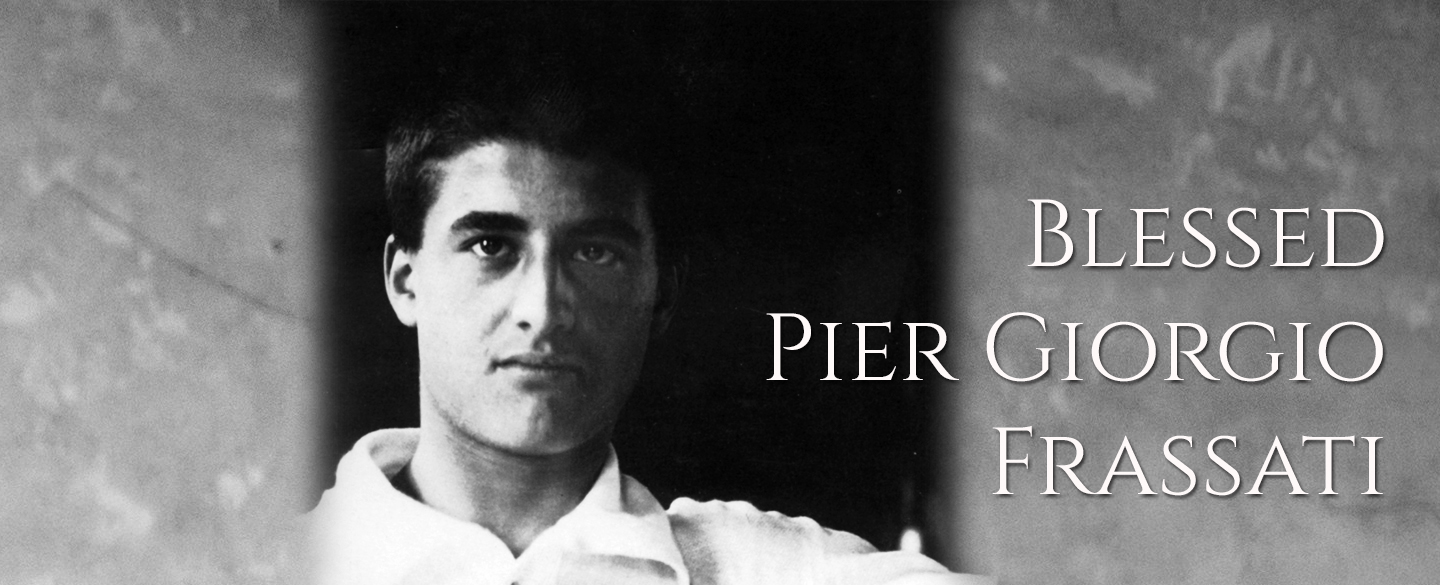
In May of 1990, Pope John Paul II beatified a young Italian whom he called “the man of our century, the modern man, the man who loved much.” The photographs we have of this youth show a handsome young man with piercing dark eyes and an engaging smile. His death in 1925 at the age of 24 was thought by many to be a tragic loss, but the Holy Father offers us the example of the life of Pier Giorgio Frassati as a dramatic gain for our century. What was there about this young person—fun-loving, energetic, forthright in his convictions—that provides youth today with encouragement in their own search for goodness and truth? What was there about Pier Giorgio that makes “hunger and thirst for holiness” a not-unlikely driving force for personal success?
A brief biography of Pier Giorgio Frassati is quick to point out that this vibrant young person, full of jokes and good cheer, comes as quite a surprise to those who suppose that only the shy, sad, and retiring can qualify as saints. Born in Turin in 1901 to a well known affluent Italian family, Pier Giorgio grew steadily and deeply in the graces of his baptism, despite quite a few challenges surrounding him. His father, an agnostic, was the founder and publisher of a liberal Italian newspaper. His mother, more sensitive and artistic by nature than her husband, saw to the religious upbringing of Pier Giorgio and his younger sister, but she worried as the boy grew older that he was becoming unnecessarily “extreme” in his personal devotion to the sacraments, prayer, and acts of charity. The lived expression of his Catholic faith, however, continued to mature in Pier Giorgio as he himself matured, and God’s grace built firmly on his lively, sensitive nature. The fact that his parents did not understand this was often a source of personal struggle for the boy. He loved his parents deeply, and the strain he saw developing in their marriage was a great source of sorrow for him as he grew older.
Pier Giorgio was educated first at home, then at a state school, and finally in a Jesuit run institution. While cultivating a natural love for beauty and the arts, he often found formal studies difficult, much to the disappointment of his success driven father. As a teenager, Pier Giorgio became involved in both spiritual organizations open to students and groups devoted to active works of mercy among the poor. Increasingly, we are told, devotion to the Holy Eucharist and to the Blessed Virgin Mary were the focus of his prayer. He began to develop a deep spiritual life, which he was never embarrassed to share with his friends. His love for God fed his devotion to the service of the poor and needy, and even drove him to political activism in support of the Church’s social teaching.
A young man with a vast capacity for both leadership and friendship, Pier Giorgio inevitably influenced the young people in his circle. Not only was he the instigator of practical jokes and fun, but he also sought to draw them unashamedly to love God and live their faith. Pier Giorgio delighted in serving the poor, and looked upon his involvement in their lives as a privilege. His own parents often misunderstood the “excess” in him as an obstacle to his future and a sign of lack of ambition. We are told that Pier Giorgio at one point made the decision to forgo the pure and tender love he felt for a young woman his age, because he knew their relationship would be cause for further tension within his own family.
At the age of 21, Pier Giorgio furthered his spiritual aspirations by becoming a member of the Dominican Laity. Here he found encouragement for his Eucharistic and Marian devotion, and further outlets for his works of mercy.
Shortly before he was to receive his degree, Pier Giorgio contracted a severe case of polio, probably caught from the sick to whom he ministered. We are told that he neglected his own health because his grandmother was dying, and that after six days of intense suffering he died on July 4, 1925. His own family had not suspected how ill he was.
Pier Giorgio’s funeral was also a revelation to his family. The poor and needy whom he had served for so many years of his short life turned out in droves to mourn him. For their part, these poor were surprised to find out that this saintly young man who had been so solicitous for them was the son of such an influential family.
Pope John Paul II remarked in 1989, after visiting the tomb of Pier Giorgio, that he also had felt in his own youth “the beneficial influence of his example.” “He left the world rather young,” he said, “but he made a mark upon our entire century.”
Feast: July 4


 Back
Back